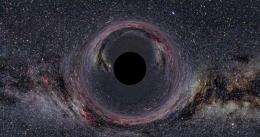Andrew Hamilton -- the man who hangs out in black holes

University of Colorado Boulder Professor Andrew Hamilton, doggedly determined to go where no man has gone before, continues to fascinate the public with his stunning and scientifically sound visualizations that take viewers into the guts of black holes.
Hamilton, a fellow at JILA, a joint institute of CU-Boulder and the National Institute of Standards and Technology and CU-Boulder, said his fascination with black holes began in the late 1990s. Hamilton’s research on the compelling stellar objects since has led him to create a number of riveting and popular video animations and visualizations.
In 2006, “Black Holes, the Other Side of Infinity,” for which Hamilton was the science director, made its debut at the Denver Museum of Nature and Science. Funded in part by NOVA, the National Center for Supercomputing Applications, NASA and the National Science Foundation, the show features sophisticated and surprising virtual journeys inside black holes and has gone on to be one of the most popular programs of its kind of all time – it has been translated into at least 10 languages around the world.
Narrated by film star Liam Neeson, the “digital dome” program visualizations were created using Hamilton’s “Black Holes Flight Simulator,” a package of supercomputing calculations, high-tech computer gaming software and century-old math equation solutions by Albert Einstein regarding quantum mechanics and gravity.
The 2006 companion piece shown on the PBS show NOVA, titled “Monster of the Milky Way,” takes the viewer inside supermassive black holes believed to dwell in the center of virtually all galaxies, including our own. In addition to being a co-science advisor, and creating most of the visualizations with his Black Hole Flight Simulator, Hamilton was the key on-air expert, exuding his British charm.
A professor in CU-Boulder’s astrophysical and planetary sciences department, Hamilton said supermassive black holes, which contain millions to billions of times the mass of Earth’s sun and appear to be at the center of virtually every galaxy, act pretty much the same as an ordinary black hole only two or three times the mass of our sun, he says. Both are voracious regions so powerful that nothing, not even light, can escape.
More recently, Hamilton produced a visualization that takes travelers into and through a Reissner-Nordstrum black hole -- an object with mass and electric charge but no spin. After free falling over the outer horizon, you reach the black hole’s inner horizon (which theoretically would vaporize you). But Hamilton’s visualization lets you survive the trip and be greeted by an infinitely bright and energetic burst of light “containing the entire history of the universe,” he says.
Even more mind-blowing, the traveler then enters a wormhole --a hypothetical tunnel connecting two widely separated regions of space-time -- inside the black hole’s inner horizon, a place where Hamilton says “space slows down, and accelerates you back out again towards the radius of the inner horizon.” Once there, you see a second infinitely bright, energetic flash of light, where you see the entire future of the universe go by.
Still there? Then you are deposited at the entrance of a white hole, a “time-reversed” version of a black hole where space falls outward at a speed faster than light. As you pass through the outer horizon of the white hole, you see a third infinitely bright, energetic burst of light containing the entire past history of a new universe.
Turning around and looking back at the white hole, you see the light from your original universe that has traversed the same journey as you -- through the black hole, through the wormhole, through the white hole, into a new universe. Whew.
Although Hamilton’s visualizations are accurate renderings of an exact mathematical solution according to the fundamental laws of general relativity, that solution is known to be violently unstable at its inner horizon - the entrance to the wormhole - and would not occur in reality, he points out. And he does lace his black hole video creations projects with scientific caveats, including this one: “Warning: If you fall in a black hole you will die. You will not go through a wormhole to another time and place.”
“It’s been a merry ride,” says Hamilton, who teaches a popular undergraduate class at CU-Boulder for non-science majors titled “Black Holes” and still does regular interviews, including a recent one with a curious Denver middle-schooler. “This black hole stuff is something society seems to want, and at my advanced age I’m obligated to give it,” he says. But don’t let him fool you: The athletic, 60-year-old Hamilton is anything but geezer. He still rides his mountain bike to campus, even in the snow.
More information: To explore black holes using Hamilton’s Black Hole Flight Simulator visit jila.colorado.edu/~ajsh/insidebh/index.html
Provided by University of Colorado at Boulder




















